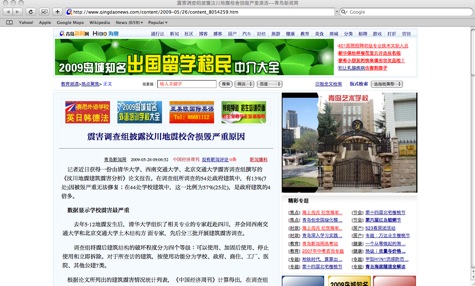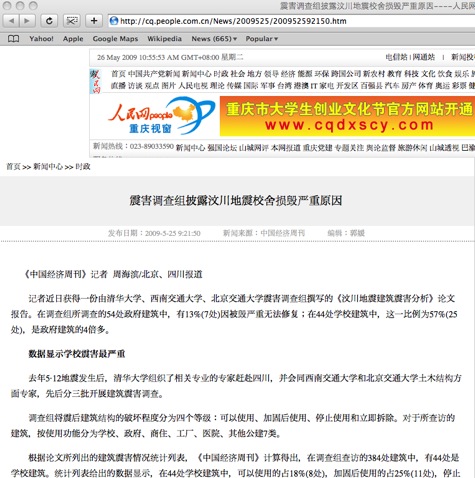Headlines and Hashtags
A news story on school collapses tantalizes, then disappears
By David Bandurski — China Economic Weekly, a spin-off magazine of the official People’s Daily, ran an important story yesterday about the collapse of school buildings in last year’s Sichuan earthquake. But the story, posted initially to People’s Daily Online, was removed by day’s end, a sign that some important officials at least were not pleased.
The original URL for the story at People’s Daily Online is now replaced with a tell-tale trace: “The page you wish to view no longer exists.”

[ABOVE: The China Economic Weekly story about a Tsinghua University report on seismic damage to buildings in the Sichuan earthquake is posted at People’s Daily Online yesterday.]
Nevertheless, this is a story to keep your eyes on — we’ve pasted the full Chinese text at the end of this post — and one that amply illustrates the complexity of China’s media environment. Where did the story come from? Why was it allowed to appear at all?
The story’s jumping-off point is an academic study on construction quality in the quake zone launched last year by Tsinghua University, but it makes much more explicit the findings of the study as they are relevant to the problem of school collapses.
The story, by reporter Zhou Haibin (周海滨), uses the numbers in the Tsinghua study to make it clear that schools surveyed by a team of experts suffered far more crippling damage in the quake than did government buildings. For example, while 44 percent of government buildings studied were still deemed usable, having sustained little seismic damage, only 18 percent of school buildings studied were still deemed structurally sound.
The article quotes the author of the paper, professor Lu Xinzheng (陆新征) of Tsinghua University’s Disaster Prevention and Mitigation Project Research Center, as saying that . . .
. . . the severity of school collapses in the quake owed not to [the inadequacy of] our nation’s earthquake mitigation means and objectives. The problem [he says] is the [failure of] application of these preventive means and objectives in particular regions. He says that owing to China’s national characteristics (我国国情) and limited national [government] strength, the level of seismic resistance [for buildings] in many local areas was as low as .5 to 1.0 when it should have been 1.5 to 2.0.
The long and short of it: negligence by local government officials.
Lu Xinzheng runs a decent personal website in both Chinese and English, which includes PDF downloads of much of his research over the last few years. There’s contact information too, but we’re supposing the news has already cycled past the earthquake anniversary so far as those editors back in New York and London are concerned, right?
Anyhow, a list of Lu’s recent earthquake-related research is here. One of the most interesting papers is a study of the structural weaknesses of buildings in last year’s Wenchuan earthquake. In this study, Lu and his colleagues write about the notable thinness (and hence weakness) of vertical supporting columns in frame structured buildings in Sichuan, which either buckled or broke when the quake struck.
“In the Wenchuan earthquake, most of the many frame structured buildings that either were damaged or collapsed were of this sort, particularly spacious and open buildings that were purely frame structured (most of which were school classroom complexes, see figure 8),” Lu and his colleagues write.
Fortunately, yesterday’s story from China Economic Weekly has not disappeared altogether. As of 10:51am today the story was still available at Qingdao News:

The article’s headline also appeared today in a list of “recent news” in the Chongqing section of People’s Daily Online, and the link was still active, taking readers to this Chongqing page with the full text of the report:

A search in the WiseNews Chinese news database suggests the story also ran yesterday on CCTV’s international website, and on the website of China News Service.
A partial translation of the China Economic Weekly story follows:
Seismic Investigation Team Reveals Causes of Severity of School Collapses in the Wenchuan Earthquake
China Economic Weekly
Zhou Haibin (周海滨) reporting from Beijing and Sichuan
This reporter recently received a copy of an academic paper called “An Analysis of Seismic Damage Caused to Structures in the Wenchuan Earthquake,” written by a seismic investigation team from Tsinghua University, Southwest Jiaotong University and Beijing Jiaotong University. Of the 54 government buildings that the investigative team studied, 13 percent (or 7 buildings) were deemed to have been irreparably damaged [by the quake]. Of the 44 school buildings that they studied, this ratio was 57 percent (or 25 schools), more than four times the level [of damage] seen with government buildings.
Numbers reveal damage to be most serious among school buildings
After the earthquake struck on May 12 last year, Tsinghua University arranged for a team of relevant experts to travel to Sichuan, and they teamed up with civil engineers (土木结构方面专家) from Southwest Jiaotong University and Beijing Jiaotong University, making a series of three investigations into seismic damage to structures [in the earthquake zone].
The investigative team classed structures sustaining seismic damage into four categories: 1) usable, 2) usable pending repairs, 3) use to be ceased, and 4) immediate demolition. Buildings were divided into types according to their purpose: school, government, business, factory, hospital and other public buildings.
According to the statistical chart provided in the paper, China Economic Weekly has determined that 44 of the 384 structures studied were school buildings. The numbers provided in the chart reveal that of the 44 school buildings studied, 18 percent (or 8 buildings) were deemed usable, 25 percent (or 11 buildings) were deemed usable pending repairs, 23 percent (or 10 buildings) were labeled “use to be ceased” (unusable) and 34 percent (or 15 buildings) were recommended for immediate demolition.
In comparison, the percentages in all categories for the 54 government buildings were: 44 percent usable (24 buildings), 43 percent usable pending repairs (23 buildings), 9 percent “use to be ceased” (unusable) and 4 percent for immediate demolition (2 buildings).
The paper also points out that schools and industrial structures suffered more serious seismic damage due in part due to the functionality of their designs. Schools suffering seismic damage were largely structures of masonry, with large-spanning rooms, large openings for doors and windows, projecting corridors, and in some cases no allowances made for quake resistance, so that their earthquake resistance was low. Factory building were also largely masonry structures, usually of small scale and spaces consisting predominantly of parking areas where there were few personnel. For this reason, little consideration was given [in factory buildings] for earthquake resistance, and seismic damage was rather severe.
Government buildings mostly used reinforced concrete frameworks, and seismic damage to these was minimal . . .
Ever since the quake struck, public opinion in China and overseas has turned to the issue of construction quality in the quake zone. Addressing concerns about “tofu engineering” [shoddily built structures], Sichuan’s acting vice-governor Wei Hong (魏宏) said in answer to questions from reporters that the collapse of schools in this major earthquake was the unavoidable result of natural disaster.
The author of this paper, professor Lu Xinzheng (陆新征) of Tsinghua University’s Disaster Prevention and Mitigation Project Research Center, believes that the severity of school collapses in the quake owed not to [the inadequacy of] our nation’s earthquake mitigation means and objectives. The problem [he says] is the [failure of] application of these preventive means and objectives in particular regions. He says that owing to China’s national characteristics (我国国情) and limited national [government] strength, the level of seismic resistance [for buildings] in many local areas was as low as .5 to 1.0 when it should have been 1.5 to 2.0.
—————-
震害调查组披露汶川地震校舍损毁严重原因
青岛新闻网 2009-05-26 09:06:52 中国经济周刊
记者近日获得一份由清华大学、西南交通大学、北京交通大学震害调查组撰写的《汶川地震建筑震害分析》论文报告。在调查组所调查的54处政府建筑中,有13%(7处)因被毁严重无法修复;在44处学校建筑中,这一比例为57%(25处),是政府建筑的4倍多。
数据显示学校震害最严重
去年5·12地震发生后,清华大学组织了相关专业的专家赶赴四川,并会同西南交通大学和北京交通大学土木结构方 面专家,先后分三批开展建筑震害调查。
调查组将震后建筑结构的破坏程度分为四个等级:可以使用、加固后使用、停止使用和立即拆除。对于所查访的建筑,按使用功能分为学校、政府、商住、工厂、医院、其他公建7类。
根据论文所列出的建筑震害情况统计列表,《中国经济周刊》计算得出,在调查组查访的384处建筑中,有44处是学校建筑。统计列表给出的数据显示,在44处学校建筑中,可以使用的占18%(8处),加固后使用的占25%(11处),停止使用的占23%(10处),立即拆除的占34%(15处)。
与此相对应,54处政府建筑的各项比例为:可以使用的占44%(24处),加固后使用的占43%(23处),停止使用的占9%(5处),立即拆除的占4%(2处)。
论文还指出,从建筑使用用途上来看,学校和工业建筑的震害最严重。震区的学校建筑主要以砌体结构为主,加上建筑上的大开间、大门窗洞、外挑走廊,有时甚至无抗震构造措施,导致其抗震性能较差。乡镇的工业厂房多为砌体结构,规模不大而且多为人员较少的车间,因此其抗震设计的要求也很低,导致震害较为严重。政府机构多用框架结构,其震害最轻。其他类型建筑的震害介于这两类建筑之间。
震后以来,国内外有舆论直指震区建筑质量问题。对于被质疑的“豆腐渣工程”,四川省常务副省长魏宏在回答记者提问时说,大地震中校舍倒塌属于不可避免的天灾。
该论文执笔人、清华大学防灾减灾工程研究所陆新征副教授认为,地震校舍损毁严重不是我国地震设防目标和手段的问题,问题在于设防目标和手段在具体地区的应用。他表示,受我国国情、国力限制,很多地区的设防烈度实际上偏低0.5度-1度,应该+1.5度甚至2度。
专家称多原因造成教室倒塌
调查组成员之一、清华大学土木工程系副教授冯鹏接受采访时表示,教室由于开间大、墙少,抗震能力比较差,所以在地震中倒塌多。
“一直以来,我国校舍的抗震设防标准和普通建筑是一样的。而在日本,校舍的抗震设防标准要比普通建筑高一度。应当把学校建成紧急避难场所,让学校成为最安全的地方。”冯鹏建议。
记者了解到,2008年7月,住房和城乡建设部、国家质量监督检验检疫总局联合发布了新修订的《建筑抗震设计规范》和《建筑工程抗震设防分类标准》,其中将学校校舍等人员密集的公共建筑提高到重点设防类,学校建筑的抗震设防烈度要高于本地1度。
“单纯质量问题不会造成大规模倒塌,原因是多方面的”,冯鹏认为,一是由于教室开间大、墙少,抗震能力比较差。二是和建设年代有关,上世纪90年代初建造的希望小学是按“89规范”来做的,倒塌情况并不严重。而那些不按规范或更早年代的学校,则毁坏严重。
此外,工程质量也被认为是影响因素之一,“所有的工程都和工程质量有关”,冯鹏表示。
国内一家建筑科研机构的一位专家表示,曾在地震后被派往灾区进行调研,他说,凡是按照抗震规范进行正规设计、且施工质量有保障的房屋,在高烈度地区大部分做到了开裂而不倒塌,在低烈度地区震害程度大部分较轻。“一所坍塌严重的学校所在地的另一所希望小学,同样的结构,却只有轻微裂缝,完全不像劫后余生的样子。”他表示。“考察中,确实发现了施工质量问题,如配料上的偷工减料,还有的不按抗震要求施工、操作上的不合理,使得震害雪上加霜。”
提高设防水平受制经济水平
据冯鹏介绍,目前我国大城市中仅有北京等少数城市的抗震设防为8度,全国省会城市中只有海口是8.5度。抗震设防度越高,抗震能力就越强。
此前,北京清华大学土木工程系教授陈肇元就提出,大规模提高我国建设安全度。
“从8度到9度,一度之差,建筑的荷载却可增加一倍。”冯鹏也表示,提高抗震设防度和经济发展水平有关,“89规范”实施前后,盖一座房子所花的钱要提高20-30%以上,因为提高抗震设防标准需要增加基建投入。公开资料显示,抗震烈度每增加一度,结构的成本可能要增加5%-10%左右。
“山西有很多地方是9度区,没有人愿意去做投资,原因就是建造成本太大。从6度提高到7度,所需成本不是非常大,从7度到8度,成本就会很大。”冯鹏坦言。
目前我国房屋建造一般都是仅满足国家最低设防标准,冯鹏建议,国家应该鼓励业主自己选择盖更加安全的房子,选择更高级别的设防标准。(记者 周海滨/北京、四川报道)
[Posted by David Bandurski, May 26, 2009, 11:39am HK]




















